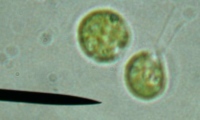Accept
Details & settings
This website uses cookies for cookie consent and statistics.
Benjamin Nöke, Tjarko Rahlf, Benjamin Weigand

It is well-known that the use of our limited supply of fossil fuels, i.e. oil, gas and coal, leads to emission of the dangerous greenhouse gas CO2. Therefore, we are looking for an environmentally friendly renewable source of energy. We found it! Green algae! Scientists discovered that green algae produce hydrogen without pollution. They need light and sulfur to grow, however, if they are deprived of sulfur, they switch to producing hydrogen, which allows them to survive for about 2 weeks without sulfur. Therefore, hydrogen production requires sulfur-containing and sulfur-free solutions. Sulfur can be removed by using a centrifuge and essentially washing the algae with sulfur-free solution or the algae can be left to use up all remaining sulfur. We have grown green algae and produced hydrogen successfully. We detected hydrogen using two methods: The oxyhydrogen reaction and gas chromatography. However, hydrogen production seems to be more challenging than expected. In research labs, hydrogen concentrations of 70% can be achieved, which can be easily detected. As we do not have a photometer, we have not been able to achieve ideal conditions for hydrogen production yet and therefore our hydrogen concentration is substantially less. We will continue to optimize our hydrogen production process to achieve higher hydrogen concentrations.
We concluded that we need to fill our reactors to a higher level. Furthermore, we need to determine the optimal chlorophyll concentration and the number of days it takes to achieve it without having a photometer.
Artificial light or sunlight can be used for illumination. The former has the advantage that red or blue light can be used which increases hydrogen production, however, it requires electricity and therefore there is no net energy production. The sun has the advantage that it supplies an almost unlimited amount of energy without consuming electricity. Its main disadvantage is that less hydrogen will be produced on cloudy days.
Nevertheless, green algae could produce enough hydrogen to supply households. Therefore, we are convinced that they are a useful regenerative source of energy. Electricity can be produced form hydrogen using fuel cells. Therefore, green algae could be a future energy solution.